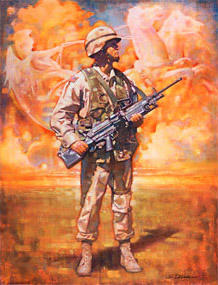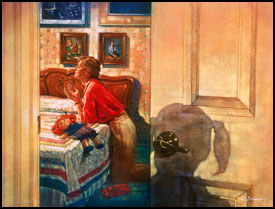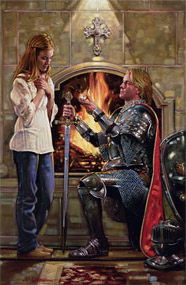When I first saw David O. Russell's
Three Kings -- the first feature film about the Gulf War --seven years ago, I cried like a five-year-old watching
Bambi. This, I knew, was an odd reaction for a heist flick starring George Clooney, Markey Mark, and Ice Cube. But it was more than the sum of its parts, a portrait of the aftermath of a war in a country the U.S. had crushed and, we thought back then, forgotten. My favorite film reviewer, Stuart Klawans, had this to say in
The Nation:
"Movies... function as wish fulfillments. In the Rambo movies, when Stallone visited himself upon Vietnam, the wish could be summed up as, "This time we win." In Three Kings, a somewhat more elevated desire is put into play: "This time we don't behave like complete shits." Even in this particular no man's land, the magical thinking of movies makes room for sentiment, so that our four Americans at last act for motives beyond dumb self-interest. The true test of the movie lies in how it goes on to realize this wish."Three Kings did so with comedy made brutal by its own madcap form and a surreal confusion epitomized by Marky Mark calling home on one of Saddam's cell phones, evidently not wholly certain which country he's in and what has happened there. And then there's the torture scene, featuring a U.S.-trained member of the Republican Guard and Wahlberg's character, played as Melville's Pip lost in an ocean of deceptions and "realpolitik" and raw suffering that he can't comprehend. Given what we now know about U.S. torture, the scene plays as quaint, but at the time it was terrifying.
I caught the movie in Montreal, where I was staying in a empty, dimly-lit and underheated mansion, a "bed-and-breakfast" I'd checked into while I spent a week interviewing
Chava Rosenfarb, the last of the great Yiddish writers, for a profile in a Jewish magazine called
Pakn Treger. Chava's house was even darker and colder, and she spoke mainly of lies and betrayal -- her own and those of her lovers, the choices they'd made to survive not just the liquidation of the Lodz Ghetto and Dachau, but also the decades since. Chava, as a young woman, had been political, but the camps had cured her of the notion that politics can avert the horrors that wash over the world like waves, regular and predictable. Never again? Chava's answer, I suspect, would be along the lines of "Probably tomorrow." Still, she wondered: Could something have been done? Could she -- 16 and powerless, a girl in a ghetto -- have done something differently? Should she have fought and died?
My questions, as I watched
Three Kings, were considerably more trival, to say the least. In 1990, as a freshman at Hampshire College, I'd thrown myself into the anti-war movement. I took part and helped organize marches, some of them enormous. I was arrested twice and knocked around -- while cuffed, no less -- by Amherst cops in a small police riot that followed the self-immolation of a war protestor named Greg Levey on the town common. By the end of the school year, though, it was all over. The huge numbers we'd put in the street were no more persuasive to Bush the First than the millions who rallied against the current episode of the war -- the largest protest in history, I've heard -- were to Bush the Second. The following winter, I spent six weeks traveling with my sister, an Arabic scholar, through North Africa. Everywhere we went, Arabs wanted us to know that they loved America, but hated Bush. "Me, too," I assured them.
"Then why did you not do something?" they asked.
That was the question that came to me in the dark as I watched
Three Kings and and thought about the absurdity of "Never again." One needn't look to Cambodia, or East Timor, or Rwanda, or the Congo in the years since the Holocaust to know how empty that phrase is; one need only turn on the TV, right now. The first Gulf War killed tens of thousands of Iraqi civilians. Whether the current war has led to the death of some 60,000 Iraqis (the very low estimate) or
600,000 (the one claimed by nonpartisan academic researchers), the scale of needless death makes a mockery of semantic debates over the terms such as "civil war" and "genocide." The proper question in response to such mass killing, undertaken in part with one's own tax dollars is not "How many corpses does it take to equal genocide?"; it's "Why did you not do something?"

I asked myself that question once again last night as I sat in the dark watching Alfonso Cuarón's new movie,
Children of Men, a dystopic thriller set in the near future, when, apparently, some kind of virus has made all of humanity infertile. Most of the world has descended into chaos. "Britain alone soldiers on," blares the announcements on the train as our hero, Theo (Clive Owen), a former radical long since disillusioned, rides home from his bureaucratic job. He's playing hooky to visit an old friend in the country, far from the madding crowd. Jaspar (Michael Caine) is a very old hippie, still radical and still ridiculous, baked and corny and yet the only seemingly fully sentient human left in a world divided between fascism -- Theo's brother, British Minister of Culture, who lives in a sterile white box petting the world's art treasures, looted by the last government still standing -- and the feral. This latter category is represented by the Fishers, a radical militia dedicated to opening Britain's borders to refugees. Theo's ex-wife, Julian (Julianne Moore) is the leader of the Fishers, and she manages to appeal to Theo's buried emotions for her, if not the cause, to enlist his help in moving one such refugee to the coast. The refugee, Kee (Claire-Hope Ashitey), turns out to be worth the trouble: she's pregnant. Julian wants to get her to a ship off the coast where scientists beyond the government's control can find out how Kee, a young African prostitute, has managed to avoid humanity's curse. But the rest of the Fishers want to keep the baby in Britain as a symbol -- a martyr, if necessary -- for their cause, and so they murder Julian. Theo takes over the rescue.
The set-up is one-third of the film. The chase that follows takes us through to the end. Along the way, Cuarón slowly reveals a response to the current worldwide "War on Terror" that's all the more effective for not being a one-to-one analogy. The fascist British government, for instance, is obsessed with the dangers of immigrants, but it's not fighting a foreign war. "Homeland Security" runs the show, and the posters warning civilians to report "suspicious activity" are dead ringers for those in the subways and on the busstop shelters here in New York, but the fight is not the same, nor is it meant to be. The Fishers at first reminded me of the Weathermen, radicals blinded by adventure and fury; it was late in the film before I recognized them as the Moktada al-Sadr's Mahdi Army, absent Islamic fervor.
But the most chilling connection was not meant to be subtle. (Spoiler ahead.) When Theo and Kee, along with a midwife named Miriam, end up in a Homeland Security prison camp, one of the first sights they witness is a man in a pointy black hood, his body covered by a poncho, his arms out as if crucified. This direct quote of Abu Ghraib is disconcerting, but heavy-handed; it's meant, I think, only to signal you to be alert to what's coming. In an effort to distract the guard from Kee's labor pains, Miriam begins praying loudly as they're transported on a bus. A dog handler drags her off. In one long shot -- as if twisting over our shoulders as the bus moves on without her -- we see another black hood shoved over her head.
The full house I saw the movie with gasped out loud. A liberal crowd, no doubt, probably 90% opposed to the war, fully aware of the routinization of torture and brutality in the name of freedom these past years. But still, we gasped. The offhandedness of the hooding, the sudden disappearence of Miriam (we never find out what happened to her), the forward motion of the bus, the plot that moves on without her, and, no doubt, the fact that Miriam is a white woman, a British citizen, a new-agey, sweetly ridiculous soul, a harmless creature, "like us," the mostly-white American middle class. We gasped. This, you could almost hear us all thinking aloud, this is what we're doing in Iraq. And then, for me and many others, I suspect, the question: "Why did I not do something?"
The question is in the past tense because what movies such as
Three Kings and
Children of Men make unbearably clear is that the damage is done. It's too late too prevent the horror, too late to avoid regret. Whether one believes we're three years into this war, or, as I do, 16, the time is long past when any honest person could maintain that the United States -- and by that I mean not just the current government, but those of us who through passivity and tax dollars and ignorance have empowered it -- is just a little off track, that in Nixon's immortal phrase, "mistakes were made," that Ford-style "healing" is possible. "Why did I not do something?" Many of us did: marched and wrote letters and wrote articles and joined organizations and campaigned for candidates and started blogs with which to spread the word. Not good enough. That's just a plain, empirical fact. All of it -- not good enough.
Was there anything we could have done that would have been good enough? At the end of
Children of Men (spoiler ahead), Theo and Kee sit in a rowboat off shore, waiting in the fog for rescue by a militant Greenpeace-type outfit with a ship called Tomorrow. They hear a rumble. The ship? Then, roaring low through the fog come three fighter jets, and suddenly the shore glows orange,

as the government's big guns suppress a Fallujah-like uprising in the prison camp with massive firepower. The thunder and the boom and the orange blossoms reminded me of
Red Dawn, the 1984 war pic in which a high school football team takes to the hills as a rebel force resisting the Soviet takeover of America. They fight bravely and with cleverness, but there's only so much they can do, and they begin to lose heart. Then, one day, U.S. fighter jets from the "free states" blast overhead and light the horizon up orange. The crowd in the theater, circa 1984, cheered. Twelve-years-old and uncertain whether "communists" were actually human, unaware that
Red Dawn was
Rambo by another name -- which is to say, a post-Vietnam fantasy in which the "good guys" win -- I cheered, too. Hooray for American firepower!
Nearly a quarter of a century later, the theater crowd for
Children of Men watched the bombing run with less joy, to say the least. (Big spoiler -- sort of.) The film ends with Kee and her baby alone in the rowboat -- Theo has slumped over, presumably dead -- as the Tomorrow sails forth from the fog. Screen goes black, then the title, white sans serif on black: CHILDREN OF MEN. Audience gasps again. No closure. Just massive firepower, technically that of the "good guys," erasing a small population, and a fishing boat for the survivors. Thin redemption, indeed. Or, perhaps: Not Good Enough.
What would be good enough? I'm not sure, but I suspect we must abandon our pieties before we'll find out. Not just the democracy-spreading delusions of the neocons, but liberal newsspeak as well, blather about "time tables" and "redeploying," "with honor," no less, a term of profound obscenity given the blood we've all helped spill. So: Step one: Let's lose our illusions. This is a process most of us must repeat over and over, and it's what good art -- especially good populist art -- is for. I am speaking here of movies like
Three Kings and
Children of Men, and books like Chava Rosenbarb's epic realist trilogy of life in the Lodz Ghetto,
Tree of Life, an undeservedly obscure masterpiece first published in two Yiddish volumes in 1972, later brought out in one unwieldy doorstop by an Australian publisher, and over the last two years released in three volumes by the University of Wisconsin Press.
Here's Chava talking about her "influences" with a Canadian radio interviewer:
The ghetto was the soil on which I really grew, I really became what I am now in a certain sense, as far as creativity is concerned, because the ghetto and the atmosphere of the ghetto and the experiences of the ghetto and human relationships in the ghetto, where you can't hide and pretend that you are somebody else, that you are noble and smart and whatnot - the person was completely naked with their soul. And that's how I learned, by observation and by being myself, immersed in that snakepit. What I saw, what I learned there gave me my outlook on the human condition, on how people are, on life in general.

(From
Lodz Ghetto Album, by Henryk Ross)



















